Mushroom Foraging in Michigan
Michigan is full of amazing wildlife and there are many ways to enjoy the space around you. A great activity that allows you to explore the wild areas of Michigan is mushroom foraging. Mushroom foraging can be tricky and certainly makes you appreciate the complexity of nature. But with a good identification book and possibly a good guide it can be a fun activity that could become a tradition.
There are many types of mushrooms in Michigan and many can be found till the fall. The season for morels, a choice mushroom, is coming up in April and it is a great time to learn about proper mushroom foraging techniques.
Materials
To forage for mushrooms, you will need a good guidebook/identification book, a mesh bag or basket, a compass or GPS and comfortable shoes. The mesh bag allows spores from the mushroom to spread across the area and the mushrooms won’t spoil.
Proper Mushroom Foraging Technique
The first thing you need to do when collecting mushrooms is to try identifying the species. Some species may be poisonous and it is best to avoid them. This is why you should never eat a mushroom unless you are 100% certain what it is. Next, pick the mushroom. There are two schools of thought for mushroom picking methods, to dig or not to dig. Digging makes sure that the volva (the lower portion of the mushroom) is intact, this structure helps identify poisonous mushrooms, but can damage the mycelium. Cutting the mushroom at its base will not damage the mycelium and ensure mushroom growth next year, but the mushroom will not have its volva. What all mushroom foragers can agree on is to not pinch or pull the mushroom as harvesting methods. These methods are sure to damage the fungus and the identification structures will be lost.
Warning
There are many species of fungus and it can be hard to distinguish one from another. It is incredibly important to know which species you are harvesting. Many edible species have poisonous look-alikes, ingesting these fungi can result in symptoms ranging from mild stomach upset to death depending on the species. The age of the mushroom matters, in some species the mushroom may only be edible at a certain age. This is why it is incredibly important to have a guide/identification book and to only eat mushrooms you are 100% certain in identifying. Note, mushrooms can cause allergic reactions, a mushroom that is safe for you to eat can cause an adverse reaction for someone else.
Mushroom str ucture
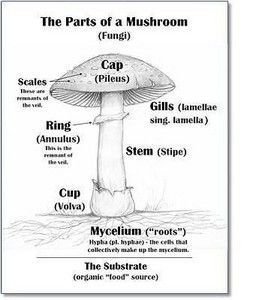
What we know as mushroo ms are just a small portion of the actual fungus. The mushroom is the fruiting body responsible for reproduction, the rest of the fungus is called mycelium. The mycelium is like the vegetative parts of plants, but instead of leaves and stems it is made up of hyphae.
Knowing the structures of a mushroom will make identification easier. A mushroom consists of a cap (pileus), gills (lamellae), stem (stipe), ring (annulus), cup (volva) and the mycelium. The shape and color of these structures help with identification. Below is a diagram describing the different cap shapes that are commonly used to identify mushrooms.
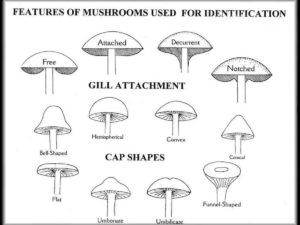
Specific Ecosystems and Mushrooms That Can be Found in Michigan
Each species of fungus is adapted to different ecosystems. To find a specific species it is valuable to know where it grows.
Aspen (Popple) Forest
This is a forest type dominated by aspen and birch. It is very short-lived and usually develops in previously disturbed areas. Currently, large patches can be found in the northern portion of the lower peninsula and the upper peninsula.
Choice Edible Mushrooms Found in Aspen (Popple) Forests
Oyster Mushroom – Only grow on aspen trees, they have a white cap, a lateral or absent stem, and have white gills that run the length of the mushroom.
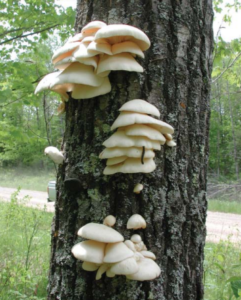
Morel (Sponge Mushroom)- The cap is deeply pitted and yellow-white. The stem is white and hollow.
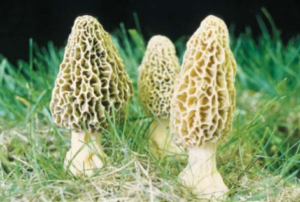
Honey Mushroom- The cap is tan to golden-brown and the stem has an obvious ring.
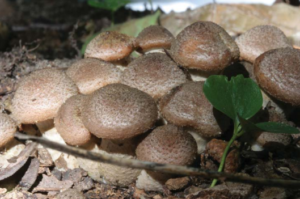
Northern Hardwood
Northern hardwood is an abundant forest type found throughout the state of Michigan. Common trees found in this forest are red maple, sugar maple, basswood, hemlock and yellow birch.
Choice Edible Mushrooms Found in Northern Hardwood Forests
Bear’s Head Tooth- Snow white spines grow from a single stem, as it ages the spines turn brown.
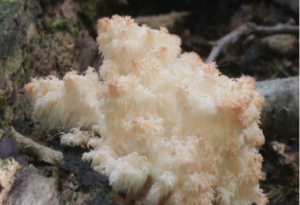
Hen of the Woods- Grows at the base of trees. The mushroom is large, gray-brown, and looks like shelves.
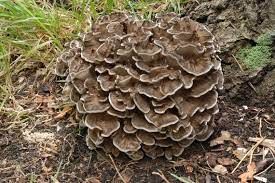
Upland Conifer
This is a forest type found on sandy, gravelly soils, or a thin layer of soil covering bedrock. Common trees are jack pine, red pine, spruce, and white pine. Upland conifer forests can be found on the northern shores of the lower peninsula and in the upper peninsula.
Choice Edible Mushroom found in Upland Conifer Forests
The King Bolete – The cap is a red-tan. The stem is striped while the flesh is white and spongy.
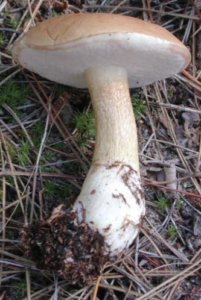
Golden Chanterelle – This is funnel-shaped, the cap is yellow, and the gills run the length of the stem.
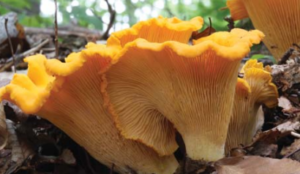
Lowland Conifer
Lowland conifer forests grow in shallow basins, along lakes and streams, and in peatlands. Common trees are black spruce, tamarack, and white cedar. They can be found in the northern half of the lower peninsula.
Choice Edible Mushrooms found in Lowland Conifer Forests
Hollow Stem Larch Suillus – The cap is dark red, hairy, and porous. The gills are netted and the stem is hollow.
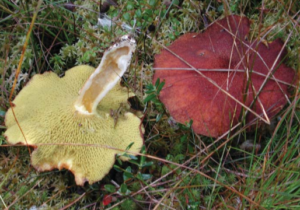
Short-Stemmed Russula – The cap can be white or yellow. It is funnel-shaped and the gills run the length of the stem.
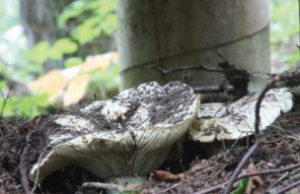
Poisonous Mushrooms Found in Michigan
Mushroom hunting is a great way to get outside, but if not done properly it can lead to serious consequences. Make sure to properly identify mushrooms and cook them properly to have the best experience possible. There are around 50 species of poisonous mushrooms in Michigan. Click HERE to see all of the identified poisonous species.
If you would like to learn more about mushroom hunting click HERE . If you would like to learn more about mushrooms in Michigan click HERE . MUCC has many volunteer opportunities if you would just like to get outside this spring click HERE.
The post Mushroom Foraging in Michigan appeared first on Michigan United Conservation Clubs.



